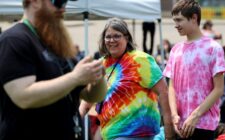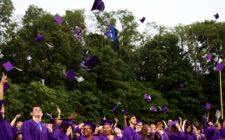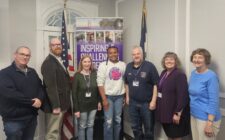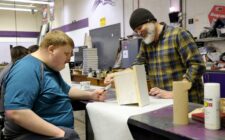Above the desk in the late Dr. Edward Stone’s southern California home office hung a framed picture of a Midwest middle school bearing his name. Halfway across the country, a framed portrait of the pioneering NASA scientist hangs in that same school’s office.
“This meant a lot to him,” his daughter, Susan Stone, said on April 28 from the first floor commons area of Edward Stone Middle School. She had just been photographing a timeline of her father’s life that students created for the school’s annual Student Spotlight event, her eyes reflecting pride and nostalgia.
Susan was among nearly 20 of Dr. Stone’s family members who traveled from California, Florida, and Illinois to visit the school named for the renowned scientist. The last time they had visited ESMS was in 2012 for the school’s dedication ceremony. This journey was prompted by a special edition of Student Spotlight that also featured more than 30 awards, models and other memorabilia that family members had carefully packaged and shipped from Dr. Stone’s home to ESMS.
“I’m so glad that the school is going to take care of it and carry on his legacy, and hopefully it inspires people,” Susan said of the items on display in the school’s auditorium.
Among those items were treasures from a remarkable career in space exploration: an American flag that had flown aboard the STS-34, the 31st NASA Space Shuttle mission that launched in 1989 and deployed the Galileo Jupiter probe. The flag had been presented to Dr. Stone by NASA in recognition of his contributions to the mission.
The collection also featured Dr. Stone’s most prized possession – a model of the Voyager spacecraft, for which he had served as project scientist for more than 50 years.
Amid the models, lifetime achievement awards, numerous certificates, and impressive statues with plaques bearing Dr. Stone’s name carefully arranged atop tables in the auditorium was a coin-shaped medal, slightly larger than a 50-cent piece, with the words “Burlington High School” arching over a Grayhound logo. The medal had been presented to Dr. Stone by his alma mater on Sept. 23, 1981.
From Burlington to the Stars
The connection to their school’s namesake offers a powerful message about possibilities to past, present and future ESMS students.
“Yes, you live in Burlington, which may not be the science capital of the world,” Susan Stone said. “But a lot of people can do great things from here, so I hope they get the message.
To help kick off the event, Janet Stone, Dr. Stone’s other daughter, addressed students, staff and community members gathered for the event in the gymnasium beneath a school logo displaying her father’s name.
“We are absolutely delighted,” Janet Stone said. “Dad would have loved this in so many different ways. He would have loved celebrating where he grew up, celebrating where he first found his love of science and exploration, and also of athletics and music and lifelong learning.”
She expressed her hope that the sense of curiosity and hunger for knowledge that guided her father to the far reaches of space will live on in Ed Stone students.
“When you see this school, when you see the memorabilia you’re about to see, Dad would love it if it sparked a new thought, a new curiosity, or a new question, and the start of something wonderful,” Janet Stone said.

Inspiration in the hallways
Throughout the building, more than 100 student projects lined the walls of the first, second, and third floor commons areas for Student Spotlight. Many were inspired by Dr. Stone’s life and achievements.
Social studies teacher Melissa Carlson, who had the privilege of meeting Dr. Stone during the 2012 dedication, incorporated his journey into her curriculum by having students compare westward expansion to space exploration.
“He came in here and he was so personal,” she recalled. “He told us stories about sitting in a cafe and hearing the news about Sputnik, and he said he just knew in that moment that’s where he needed to be. He needed to go and be part of this. Hearing him tell it, it still gives me goosebumps today.”
On the third floor, dozens of balloon-powered cars accompanied by data documenting their speed and distance were on display – a hands-on project thoroughly enjoyed by students in Devin Rohr’s math classes.
Lucy Wyatt’s seventh grade math students explored how gravity changes across the planets in our solar system. Using real planetary data, they calculated their weight and the weight of common objects on each planet and presented their findings with displays, graphs and other visuals.
Meanwhile, her computer science students became space pioneers tasked with working alongside Global Travellers United to design a new colony on a distant planet. For this project, students needed to use critical thinking to select additional crew members from a list of 15 potential specialists based upon the skill sets that would best meet the needs of their colony. They also needed to design and graph their settlements to include a home, kitchen and hospital.
“As you explore each student’s work,” Wyatt wrote, “we invite you to consider the legacy of Dr. Edward Stone, a visionary who reminded us that: Even the most distant frontiers can be explored through curiosity, courage, and collaboration.”
Students in Kimberly Smith’s science class completed a multi-part project consisting of weather and space phenomena posters, along with written paragraphs about one of the donated artifacts.
“Students had so much fun completing these projects,” Smith said.
Not all projects were STEM-themed.
Cherie Reid and her students designed the hallway outside their classroom around careers, using Dr. Stone’s life as inspiration.
“I like the saying of ‘inspiring and challenging students,’” Reid said, referencing the mission of the Burlington Community School District.
“It’s just like he did in his life. He was inspired and challenged, and he got pushed to excellence and that’s what I expect from my students.”

Students Respond
For students, the connection to someone who achieved so much has made an impression.
“It’s pretty awesome to see because he’s the one the school is named after and it’s pretty cool to see all the stuff that he has collected and all the awards that he’s won,” said Becket Tysland, an eighth-grader who particularly enjoyed comparing westward expansion to space exploration.
For others, Dr. Stone’s accomplishments were proof that big possibilities can take root anywhere, even in a small town.
“I think that it’s pretty good because Burlington is a small town,” eighth-grader Jaquan Harrison said. “And for someone to achieve what he did, like getting a school named after him, I think that’s pretty good.”

A personal legacy
Beyond his scientific achievements, family members remember Dr. Stone as a man whose extraordinary qualities extended beyond his professional accomplishments.
“He was a fundamentally very nice person, and he was very smart,” Susan Stone said. “He was a gifted person. He could explain things that were super complicated so that anybody could understand them. It was amazing. It was really a gift.”
She added that her father “loved to learn his whole life. He was one of those people who would go to a museum and want to read everything in there and learn about whatever the museum was about.”
Susan Stone said her father instilled that same love of learning in his children and grandchildren. That passion was evident in Janet Stone’s address to the audience.
“No matter where you grow up, no matter what your passion, no matter how you lay your path or what you eventually discover along that path, every idea can be a beginning,” she said.
For the students of Edward Stone Middle School, those beginnings now have a tangible connection through the items that once belonged to the man whose curiosity led him from a small Iowa town to the farthest reaches of our solar system.












